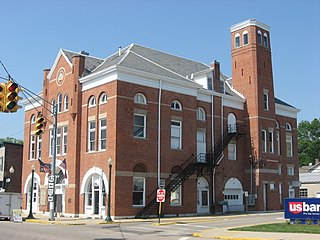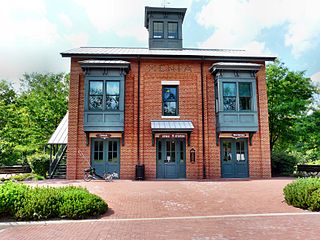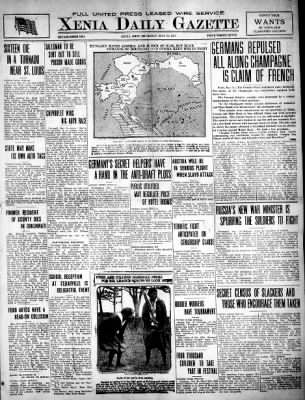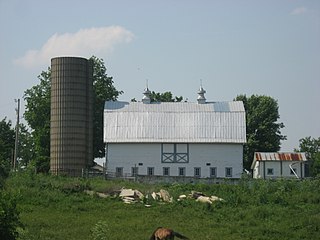
Greene County is located in the southwestern portion of Ohio. As of the 2020 census, the population was 167,966. Its county seat is Xenia and its largest city is Beavercreek. The county was established on March 24, 1803 and named for General Nathanael Greene, an officer in the Revolutionary War. Greene County is part of the Dayton, OH Metropolitan Statistical Area.

Cedarville is a village in Greene County, Ohio, United States. The village is within the Dayton Metropolitan Statistical Area. The population was 4,257 at the 2020 census.

Xenia is a city in and the county seat of Greene County, Ohio, United States. Located in southwestern Ohio, it is 15 miles (24 km) east of Dayton and is part of the Dayton metropolitan area as well as the Miami Valley region. The name comes from the Greek word Xenia (ξενία), which means "hospitality".
The Greene County Public Library serves the communities of Greene County, Ohio. The library system's administrative offices are in Xenia, and other branches are located in Beavercreek, Cedarville, Fairborn, Jamestown, Bellbrook, and Yellow Springs. Greene County Library is a member of the Miami Valley Libraries, one of eleven regional library cooperatives in Ohio.

Beavercreek Township is one of the twelve townships of Greene County, Ohio, United States. As of the 2020 census the township population was 56,026.

Cedarville Township is one of the twelve townships of Greene County, Ohio, United States. As of the 2020 census the township population was 5,899.

Watertown is an unincorporated community in southwestern Watertown Township, Washington County, Ohio, United States. It has a post office with the ZIP code 45787. It lies near the intersection of State Routes 339 and 676 near Wolf Creek, which meets the Muskingum River at Waterford to the north.

Xenia is a unincorporated in Franklin Township, Bourbon County, Kansas, United States.
The Dean Family Farm, listed since 1975 as a historic site on the National Register of Historic Places, has its origins with the immigration of Daniel Dean, a native of Tobermore, County Londonderry, Ireland, to Philadelphia, Pennsylvania, in 1784 when he was aged 18, according to Dean family histories. Daniel was a son of George Roger Dean, who fought in the Colonial line, and Mary Campbell who was reared with her sister by the Duke of Argyl at Inveraray Scotland, the clan Campbells' ancestral home.

Xenia Station, located at 150 Miami Avenue in Xenia, Ohio, in the United States, is a replica of Xenia's 1880s brick railroad station.

The U.S. Post Office in Suffern, New York, is located on Chestnut Street between NY 59 and US 202, on the northern edge of the village's downtown business district. It serves the ZIP Code 10901, covering the village of Suffern.

Goes Station is a small unincorporated community in northern Xenia Township, Greene County, Ohio, United States. It sits at the intersection of Snively Road and U.S. Route 68 between Xenia and Yellow Springs.

The Bank of Xenia is a historic former bank building in downtown Xenia, Ohio, United States. Built in 1835, it was the location of Greene County's first bank, which opened on June 1 of that year. For thirty years, the building was used as a bank, becoming the local branch of the State Bank of Ohio in 1846 and changing its name to First National Bank in 1863. After First National moved to a newer building in 1865, it was no longer used as a bank; among its later owners was A.C. Messenger, a physician who used it as his home and office. In the 1880s, the bank was a party to a lawsuit known as Xenia Bank v. Stewart, which was decided by the United States Supreme Court in 1885.

The Cedarville Opera House is a historic theater in the village of Cedarville, Ohio, United States. Erected in 1888 on Main Street in downtown Cedarville, it has been a premier part of community life since its construction.

The Xenia Daily Gazette is a Pulitzer Prize-winning American daily newspaper published twice per week in Xenia, Ohio and its surrounding area. It is owned by AIM Media based in McAllen, Texas.

The Whitelaw Reid House is a historic residence near the village of Cedarville in Greene County, Ohio, United States. Built in the early nineteenth century, it was home to a prominent American journalist, and it has been named a historic site.
Indian Mound Reserve is a public country park near the village of Cedarville, Ohio, United States. Named for two different earthworks within its bounds — the Williamson Mound and the Pollock Works — the park straddles Massies Creek as it flows through a small canyon.

The McDonald Farm is a historic agricultural complex near the city of Xenia in Greene County, Ohio, United States. It has been named a historic site, largely because of a quarry on the farm, which supplied stone for the Washington Monument.

The Wright-Patterson Air Force Base Mound, designated 33GR31, is a Native American mound near the city of Dayton in Greene County, Ohio, United States. Named for its location on an Air Force facility, Wright-Patterson Air Force Base, the mound is an archaeological site.

The Harper Mausoleum and George W. Harper Memorial Entrance are a pair of funerary structures in the village cemetery at Cedarville, Ohio, United States. Commemorating one of Cedarville's wealthiest nineteenth-century citizens, they have together been named a historic site because of their distinctive Egyptian-style design.




















